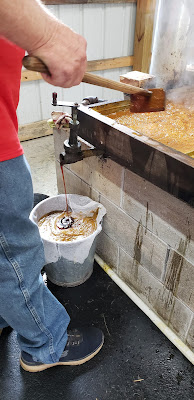56f this morning, heavy dew, clear skies.
Yesterday we took a little road trip to another festival, this one the West Virginia Molasses Festival in lovely and very rural Calhoun County.
We attended this festival some years ago and always meant to go back but you know how that is. In that post, I wrote about how the syrup is made in detail so
click here if you want to see photos of the milling process because I didn't take any of the cane being pressed yesterday.
We used to grow sorghum and make our own 40+ years ago, and I admit I miss it.
The cooks at the festival were the Mace Brothers. Three of them were on hand yesterday. Here you can see the molasses pan, a large evaporator over a gas furnace. The pan is divided into 5 sections, and as the sap cooks, water evaporates causing steam. Impurities rise to the surface as a green scum which must be skimmed off.
This is the first section, the raw sap that has been pressed out of the canes by the roller mill. In old days, horses turned the mill, but today an electric motor is used. We used to use the three-point hitch on our tractor to do that job.
That scum looks nasty, doesn't it?
I watched a good while, talking to the guys cooking, until one of them said, "That skimmer will fit a woman's hand as well as a man's!" So all righty then! I was put to work for a couple hours, and was thrilled to be able to do this again. It sure brought back memories.
At the other end of the pan, the molasses is just about ready to pull off. Mr. Mace explained to me that every year the sugar content of the cane is different, and also varies from field to field. Weather--too much or not enough rain, soil type and seed variety all impact the sugar content. We knew nothing about that back when we made molasses, but did notice the variation in the syrup from field to field. We found that the cane grown on our sandy ridge made a sweeter, lighter syrup than that grown in bottomland. These days they have a meter, which looks like a small telescope with something like a microscope slide on the end. You put a little sap on the slide, close a lid over it, and look through the eyepiece to see a graph with numbers that show the sugar content. Pretty cool.
And into the bucket, through a straining cloth, it goes!
Then strained again, and jarred up.
Hard at work! Not, it is easy, repetitive work actually. The hard part is at the other end, judging the temperature, when to move the sap along, when to pull off the finished product.
Dumping those green skimmings into a bucket. Yucky.
The finished product, at home in my kitchen.
The pan was pretty hot at this point and boiling hard. Look at that steam!
Here is what sorghum cane looks like. It is very similar to corn, and even closer to broom corn, really.
The three Mace brothers, all in their 70s. I asked if they had any younger people interested in learning this craft, and they said they can't find anyone who wants to learn. Will this be another old-time skill that disappears? I hope not. I am already looking forward to next year.
Copyright Susanna Holstein. All rights reserved. No Republication or Redistribution Allowed without attribution to Susanna Holstein.















Good to see you hard at work. Since the Mace brothers don't have anyone to take over their craft, perhaps you might want to give it a go since you have experience.
ReplyDeleteWell, the problem is, I am about the same age as tbe Mace brothers! I might be a year or two younger but thats not much help.
Deletewow Fresh made molasses must taste amazing!
ReplyDeleteAngie's, it does. This is very different from blackstrap molasses, which is actually made from sugar cane. Sorghum molasses has a milder taste. I use it to make molasses cookies, gingerbread, fried apples, and in bread. It is also delicious mixed with butter, very like honey butter, and spread on hot biscuits--not English biscuits, lol, but the American ones.
DeleteI'm not sure if you can even buy molasses over her, it's certainly not a common thing.
ReplyDeleteIt used to be the main sweetener used in southern Appalachia, John. But over the years, as sugar became easy to buy, people moved away from it. The stripping and cutting of the stalks is hard work. In old days a man with the mill, as they called the equipment needed, would move his mill from one place to another. People would put him up and whole regions would bring in their cane to be cooked. So the cooking down was quite a festive event
ReplyDeleteWhat an interesting process. We haven't seen molasses over here and seldom use it in anything,.
ReplyDeleteI don't use a lot of it, Bill. Too pricey! But if I can get it, I use about a quart a year in baking. Makes the best fried apples!
DeleteYou are so "cool"! Ha, what fun!
ReplyDeleteSad they find no one to fill in.
Here we have some so called "start-up"-teams who learn the "old"-style in beer making
You know, this state offers apprenticeships in a wide variety of old time arts and crafts. It seemsblike molasses making would qualify.
DeleteDo they use a refractometer to determine the sugar level? The same thing is used to determine alcohol content in distilling. That is a very interesting process, I am glad that you got to relive some memories by doing a little skimming!
ReplyDeleteI had to look that up, Jim, but that is exactly what they use! Thanks for educating me, I had no idea what it was called.
Delete